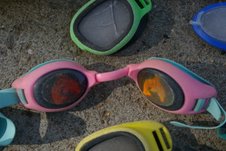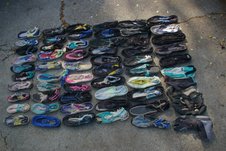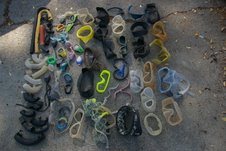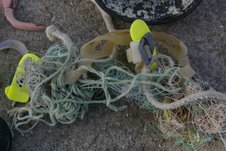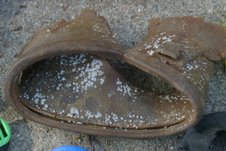Hi June,
“J‘Accuse!,” my friends in Half Moon Bay.
Yes, I accuse your fair city and its residents and visitors of being responsible for the enormous amount of non-buoyant marine debris making the southward “Silent Procession” of which just a small portion is spit out by Neptune’s Vomitorium onto Invisible Beach. Through the carelessness of your industries, your recreational activities, and your improper disposal of no longer wanted items you are turning the ocean into a gigantic trash can. While it was the tracing of the golfballs and their remnants to the Ritz Carlton golf courses south of Half Moon Bay, that established the first point source I was convinced of, there was much earlier evidence of Half Moon Bay’s complicity.
Though the fishing and crabbing industry, both commercial and recreational, contribute a large portion of the debris to my collection, especially of the debris that has the potential of damaging marine life, I’ll leave that for another email. Instead, I’d like to focus on the types of debris that led me to identify Half Moon Bay and possibly its northern neighbor, Pacifica, as the sources of much of the stuff I was gathering.
Kayak shoes and swim goggles were what first piqued my interest and pointed me in the right direction..
Being a kayaker who has lost kayak shoes both when thrown into the Colorado River outside of Moab, Utah and more relevantly when landing my kayak in moderate surf at Bean Hollow Beach, I didn’t immediately “smell a rat” when I started finding kayak shoes at Invisible Beach. But, the number of shoes I was finding, as well as their size quickly caught my interest. Although, I do it and know others do occasionally, I’ve never seen anybody kayaking this far south of HMB, even while walking the beach during hundreds of hikes. More importantly, were the many small size kayak shoes I was finding an indication that there were tiny tots who had taken up the sport and were plying the icy waters around Pescadero? Not too likely, I decided. But, kayak shoes are also popular with beach users and tide pool walkers, both for their functionality and washability, so I didn’t make much of it.
My growing collection of swim goggles and masks was another matter.
Being a former resident of San Diego, then Hawaii, recreational diving or snorkeling in the frigid waters of the Red Triangle have never had much appeal to me. In all my prowling of the beaches south of the Ritz Carlton, I have only seen two people attempt to snorkel and that was at the protected, sandy-bottomed Fiddler’s Cove, and then only for ten minutes.
Admittedly, while I haven’t seen them, there are plenty of others made of sterner stuff then I am who scuba dive or abalone dive or practice photography underwater in these dangerous waters. There are plenty of websites that relate their exploits and share their photos. I also find their equipment and its remnants on occasion, be it dive knives, regulator parts, swim fins, etc. But, what could be the explanation of the preponderance of children’s goggles and masks in my collection?
Were irresponsible parents practicing a sub-category of child abuse by allowing their children to enter the dangerous, riptide-afflicted icy waters hereabouts? Fortunately, the answer is no. If it was so, I’d remember the fuss created when their parents were charged with complicity in their drowning.
Rather, I believe it is from the much safer sandy beaches south of Pillar Point Harbor that these objects begin their journeys.. Beaches with names like El Granada, Dunes, Francis, Roosevelt and Venice. If anyone should recognize an object in any of the photos I’ll attach to this email I would be thrilled to hear from them. On infrequent occasions I find identification tags from marine mammals, birds, and commercial fishing equipment, but those are hard to track to their origin by only using the Internet.
While I’ve mentioned the longshore current previously, I’d like expand on its actions and where it takes all this trash eventually in a future email about littoral cells and submarine canyons. Until then, please take all of your stuff home from the beach, especially your children. Enjoy. John Vonderlin.
P.S. This photo
is of an assemblage of fishing line and cord intertwined with the remnants of a swimming mask. And this one
is of a swim mask that must have been out there a long time as barnacles do not like starting their one and only home on rubber or plastic. The last photo 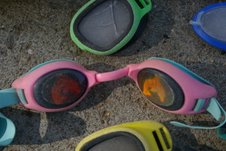
is of an unusual pair of children’s swim goggles.
P.S.S. From Wikipedia
The Red Triangle is the colloquial name of a roughly triangle-shaped region off the coast of northern California, extending from Bodega Bay, north of San Francisco, out to a bit beyond the Farallon Islands, and down to the Big Sur region, south of Monterey. The area has a very large population of marine mammals, such as elephant seals and sea lions, which are a favored meal of great white sharks.[1] It has also been estimated that of all documented great white shark attacks on humans, more than half have occurred within the Red Triangle.[2] The area encompasses the beaches of the heavily-populated San Francisco Bay Area, and many people enjoy surfing, swimming and diving in these waters. Some have been attacked by great white sharks.[3] The “Red” in “Red Triangle” refers to the red blood in the water, after a shark has made its attack.[citation needed]

